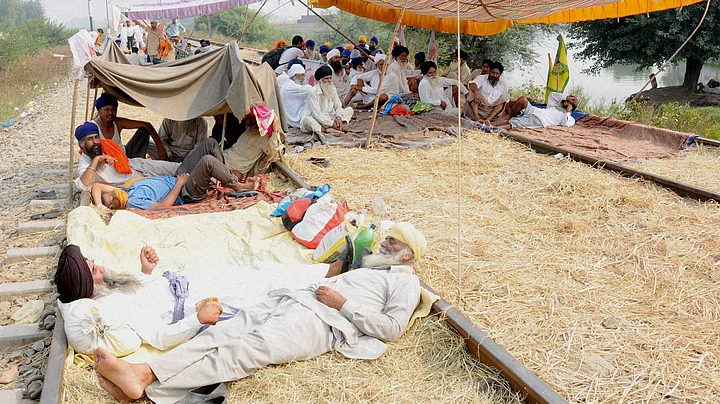As farmers in Punjab resume their agitation, demanding compensation for their damaged crops, here’s a look at how whitefly attack has dashed hopes of farmers across the state.
They are like flakes of dandruff on the underside of leaves. What they lack in size they make up with numbers and an ability to quickly multiply. They pack such menace that they have brought Punjab’s cotton farmers down on their knees ─ and last week ─ on to railway tracks.
In Pathrala, Shergarh and Rampura, cotton farmers squatted on rail lines connecting Bhatinda, a cotton hub, with the rest of the country, forcing the cancellation or diversion of about 450 trains and inconveniencing thousands of passengers.
Across Bhatinda, Abohar, Fazilka, Mansa and Muktsar districts, swathes of cotton crop have been laid waste as the whitefly pest went about sucking their life juices dry. Leaves have turned brown, the plants are stunted, the pods few in number and the cotton bursting out of them half the normal weight. Dull white fluffs speckle the fields.
Tales of Failed Crops
Surendra Sharma, of former speaker and agriculture minister Balram Jakhar’s Panjkosi village, is distraught. A landless famer, he grew cotton on 15 acres of leased land at an annual rental of Rs 30,000 an acre, paid with loan contracted from a commission agent at 2% interest per month. He has ploughed eight acres of the crop into the ground and from the rest he expects to harvest about a quintal per acre, against eight to 10 quintals an acre last year.
His neighbour Anuj Kajla, 22, has written off 45 acres of cotton, despite stiff efforts to save it.
At the new mandi in Fazilka, commission agent Amritlal Gumber’s attention is focused on paddy, when his dhyan last year around this time was on cotton, which arrives earlier.
Farmers in Distress
- Farmers protested across Punjab as cotton crops suffered damage due to whitefly attack
- Delay in sowing and releasing water from canals reason behind pest attack
- Excessive use of urea by farmers also led to stunted crops
- Spurious pesticides suspected to have caused damage
- Politicians blame corruption and poor governance for the whitefly outbreak
The Experience Last Year
The patch of white in his front yard stands out in relief. It is the harvest of Chandra Bhan of Jhandawala Bimesha village. He managed to salvage six quintals an acre from his cotton crop of 70 acres, both own and leased, by giving as many as 13 sprays. Last year, he says, his yield was double and the whitefly was quickly brought under control.
Gyan Chand, of Fazilka’s Chahlan village, planted just four of 45 acres with cotton, against 12 last year because of a drop in prices. He is unlikely to take chances with it in the coming season because he has managed to extract just 1.5 quintals an acre despite spending Rs 17,000 on little-known chemicals.
Outbreak’s Reasons
The outbreak is blamed on a combination of factors. Humid weather and day temperatures of less than 40 degrees centigrade created conducive conditions. More than half of Punjab’s cotton was sown late, that is, after May 15, because of delayed wheat harvesting and late release of water in canals due to de-silting operations.
The percentage of late sown cotton was less in Rajasthan and Haryana. White fly infestation happened two months earlier than usual, in the second half of June, says Paramjit singh, Director of Punjab Agriculture University’s (PAU) regional research station in Bhatinda. White flies feasted on the young succulent plants.
K R Kranthi of the Central Institute of Cotton Research (CICR), Nagpur, says rains wash off the eggs, but in Punjab it was insufficient and scattered. Farmers applied excessive urea, he says, as the crop appeared to be stunted. Instead of spraying the recommended four pesticides singly, farmers applied a cocktail which killed the natural enemies of the white fly (bugs, spiders and two kinds of parasites) without much damaging the pest, which has a waxy coating.
He does not agree that anticipation was lacking. PAU and CICR, he says, have a voice-mail service called e-Kapas on which 72,215 farmers are registered. Ten lakh messages were sent through this service, he says.
Spurious Pesticides?
In the Punjab countryside, talk of spurious pesticides is rife. When there is an outbreak and farmers are desperate, unscrupulous opportunists will rush in. But stocks across the state cannot be adulterated. PAU had recommended four pesticides to be used singly and sequentially. The farmers said they were all ineffective, including those manufactured by reputed companies, which is why they tried a mix of them.
“I believe this is an attempt to grab land,” says Balwant Singh of Kaljharani adjoining Badal, the chief minister’s village. “If there are crop failures farmers will give up land to companies.” Singh has lost both his cotton and moong bean crops to the white fly. He says rates per acre in the village have declined from Rs 25 lakh to around Rs 10 lakh. “How is it that all sprays have failed? It is a conspiracy.”
Allegations Fly Thick and Fast
The whitefly outbreak “is a symptom of corruption, poor governance and weak leadership,” says Manpreet Singh Badal, former finance minister and president of People’s Party of Punjab. Badal fell out with his chief minister uncle in 2010, for voicing concerns about Punjab’s mounting debt.
Badal’s view is endorsed by a PAU official who says the “cotton crop has been destroyed in the entire (Malwa) belt.” The system is so steeped in corruption “you cannot imagine it.”
The protests have been called off with the assurance of meagre relief. The government, the scientists and pesticide companies all have their explanations and excuses. They are all in the clear. It is weather and farmers themselves who are to blame!
(The writer is consulting editor to www.smartindianagriculture.in)
(At The Quint, we question everything. Play an active role in shaping our journalism by becoming a member today.)
